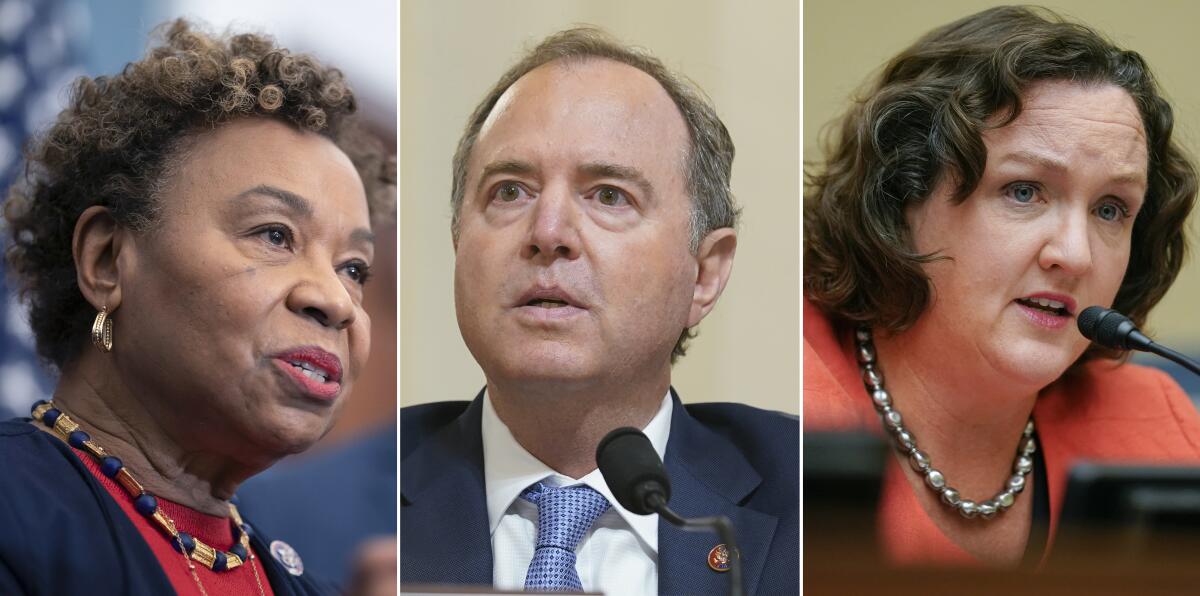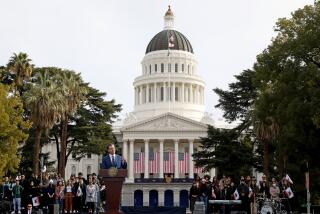Opinion: Can California’s top-two primary handle the race for Feinstein’s seat? Don’t count on it

California‘s Sen. Dianne Feinstein, the oldest member of Congress, announced her retirement this week effective next year, which will end a remarkable career of leading on key issues such as gun control and environmental protection. In a less polarized era, her moderate politics sometimes allowed her to bridge the gap between the parties on tough issues.
Now a stampede to succeed her is afoot. Two prominent Southern California Democrats, Reps. Katie Porter and Adam B. Schiff, have already declared their candidacies. Democratic Oakland Rep. Barbara Lee filed papers for a run Wednesday, and another Bay Area Democrat, Ro Khanna, could join. With no shortage of elected California Democrats looking for their next job and a likely price of admission to the race in the tens of millions of dollars, it could be an all-out slugfest among some of the party’s top names.
The state’s unusual approach to elections has some envisioning a general election contest between Democrats, which the state’s open top-two primary allows. But in the decade since it debuted, the top-two system has often yielded disappointing results. Will it really ensure that the most popular and unifying candidate wins?
In California’s system, all candidates run on the same ballot in the spring regardless of party. The top two finishers advance to the general election in the fall, also regardless of affiliation. But the reform can result in spoiler candidates and split votes among front-runners from the same party. When too many contenders run, the results can get strange and contrary to the principles of majoritarianism.
In some state legislative districts, for example, split votes and spoilers have resulted in the top two candidates each advancing with around 20% of the vote or less, meaning the preferences of a majority of the electorate proved irrelevant. In one Republican-leaning Central Valley district last year, two Democrats advanced to the November election because a crowd of Republicans fragmented the conservative majority. Conversely, Democratic districts have ended up with a choice between Republicans.
With so many substantial Democratic candidates running for Feinstein’s Senate seat, the election could come down to the equivalent of a roll of the dice. The race could also be vulnerable to gamesmanship. In one San Diego-area congressional race in 2012, for example, a Democratic state senator spent as much as $50,000 to support a penniless Republican opponent to prevent the lawmaker’s strongest rival, a fellow Democrat, from reaching the general election.
Last year’s statewide primaries for controller and insurance commissioner featured multiple Democratic contenders who split the vote, advancing sacrificial Republicans to the general.
And forget about unaffiliated or third-party candidates. Since California began using the top-two primary in 2012, only a handful of such candidates have reached the November ballot.
Political candidates and their consultants will inevitably try to manipulate the rules to win. Change the rules and you provide different incentives, which result in different behaviors and sometimes different outcomes, though not always the ones reformers intended.
There is a simple, home-grown solution to the discontents of the top-two system. San Francisco, Oakland and several other California cities have pioneered ranked-choice voting to elect officeholders. This method allows voters to rank multiple candidates on their ballots by order of preference. The rankings are used in a series of “instant runoffs” to eliminate the least popular candidates until a winner is elected with more than 50% of the vote. If your first choice can’t win, your vote goes to your next-ranked candidate.
Ranked choice could be used to elect the Senate candidate who enjoys the broadest support, preventing spoiler candidates, split votes and political chicanery from turning the election into a casino game. And instead of merely attacking each other, candidates would be encouraged to find common ground with their rivals to draw more second- and third-choice rankings. A single ranked-choice election in November could even eliminate the need for a primary election, saving taxpayers millions.
California could follow the path blazed last year by Alaska, which combined ranked-choice voting with a top-four primary. This method sends the top four finishers to a November election in which voters rank their favorite candidates, maximizing voters’ options, making elections more competitive and diminishing the role of split votes and spoiler candidates.
What kind of senator would best serve California? Another moderate who can reach across the aisle? Or a strong progressive who embodies the multiracial, multi-everything place the Golden State has become?
The next senator will represent a state that has been transformed during Feinstein’s many years in office. The 2024 contest already is showing fissures in the regional and racial makeup of the state. The largest demographic is now Latino, and the divide between the wealthier Bay Area and the poorer and more diverse Los Angeles region has widened, helping Northern California dominate state politics.
We appear to be stuck with the top-two primary for this race, but with Alaska, Maine and Nevada all adopting ranked-choice voting in recent years, change may be on the horizon. California should help lead the country away from the polarized and antidemocratic politics engulfing Washington by refining its election reforms to truly reflect the will of voters.
Steven Hill publishes DemocracySOS and is the author of “10 Steps to Repair American Democracy.”
More to Read
A cure for the common opinion
Get thought-provoking perspectives with our weekly newsletter.
You may occasionally receive promotional content from the Los Angeles Times.










